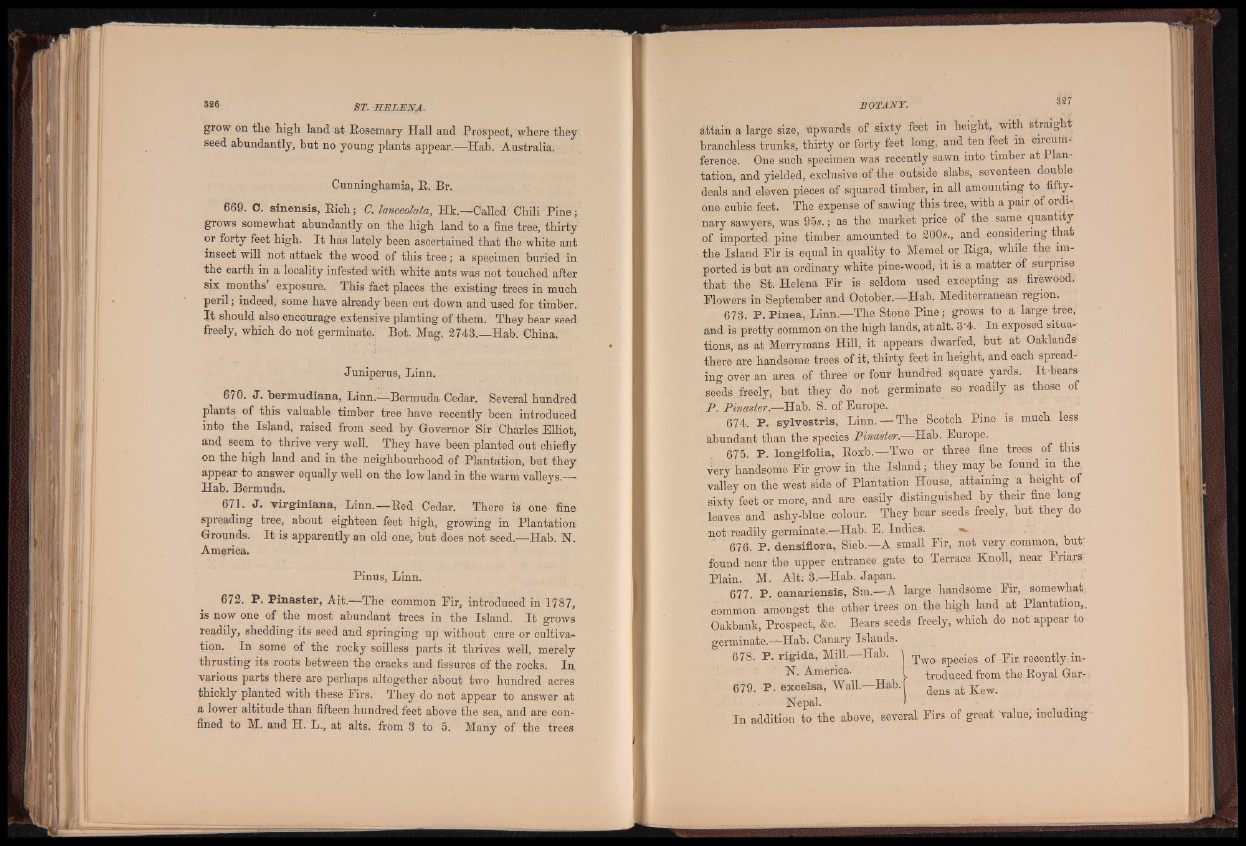
grow on the high land at Rosemary Hall and Prospect, where they
seed abundantly, but no young plants appear.—Hab. Australia.
Cunninghamia, R. Br.
669. C. sinensis, Rich; C. lanceolata, Hk.—Called Chili P in e;
grows somewhat abundantly on the high land to a fine tree, thirty
or forty feet high. I t has lately been ascertained that the white ant
insect will not attack the wood of this tre e ; a specimen buried in
the earth in a locality infested with white ants was not touched after
six months exposure. This fact places the existing trees in much
peril; indeed, some have already been cut down and used for timber.
I t should also encourage extensive planting of them. They bear seed
freely, which do not germinate.: Bot. Mag, 2743.—Hab. China.
Juniperus, Linn.
670. J. bermudiana, Linn.—Bermuda Cedar. Several hundred
plants of this valuable timber tree have recently been introduced
into the Island, raised from seed by Governor Sir Charles Elliot,
and seem to thrive very well. They have been planted out chiefly
on the high land and in the neighbourhood of Plantation, but they
appear to answer equally well on the low land in the warm valleys.—
Hab. Bermuda.
671. J. virginiana, Linn.—Red Cedar. There is one fine
spreading tree, about eighteen feet high, growing in Plantation
Grounds. I t is apparently an old one, but does not seed.—Hab. N.
America.
Pinus, Linn.
672. P. Pinaster, Ait.—The common Pir, introduced in 1787,
is now one of the most abundant trees in the Island. I t grows
readily, shedding its seed and springing up without care or cultivation.
In some of the rocky soilless parts it thrives well, merely
thrusting its roots between the cracks and fissures of the rocks. In
various parts there are perhaps altogether about two hundred acres
thickly planted with these Pirs. They do not appear to answer at
a lower altitude than fifteen hundred feet above the sea, and are confined
to M. and H. L., at alts, from 3 to 5. Many of the trees
attain a large size, upwards of sixty feet in height, with straight
branchless trunks, thirty or forty feet long, and ten feet in circumference.
One such specimen was recently sawn into timber at Plantation,
and yielded, exclusive of the outside slabs, seventeen double
deals and eleven pieces of squared timber, in all amounting to fifty-
one cubic feet. The expense of sawing this tree, with a pair of ordinary
sawyers, was 95s.; as the market price of the same quantity
of imported pine timber, amounted to 200s., and considering that
the Island Pir is equal in quality to Memel or Riga, while the imported
is but an ordinary white pine-wood, it is a matter of surprise
that the St. Helena Pir is seldom used excepting as firewood.
Flowers in September and October.—Hab. Mediterranean region.
673. P . P i n e a , Linn.—The Stone P in e ; grows to a large tree,
and is pretty common on the high lands, at alt. 3'4. In exposed situations,
as at Merrymans Hill, it appears dwarfed, but a t Oaklands
there are handsome trees of it, thirty feet in height, and each spreading
over an area of three or four hundred square yards. It-bears
seeds freely, but they do not germinate so readily as those of
jP. Pinaster.—Hab. S. of Europe.
674. P . s y l v e s t r i s , Linn. — The Scotch Pine is much less
abundant than the species Pinaster.—Hab. Europe.
675. P. longifolia, Roxb.— Two or three fine trees of this
very handsome Fir grow in the Island; they may be found in the
valley on the west side of Plantation House, attaining a height of
sixty feet or more, and are easily distinguished by their fine long
leaves and ashy-blue colour. They bear seeds freely, but they do
n o t readily germinate.—Hab. E. Indies. ■
676. P. densiflora, Sieb.—A small Pir, not very common, but-
found near the upper entrance gate to Terrace Knoll, near Friars
Plain. M. Alt. 3.—Hab. Japan. :
677. P. c a n a r i e n s i s , Sm.—A large handsome Pir, somewhat
common amongst the other trees on the high land at Plantation,.
Oakbank, Prospect, &c. Bears seeds freely, which do not appear to
germinate.—--Hab. Canary Islands.
678. P. rigida, Mill.—flab.
N. America.
679. P. excelsa, Wall.—Hab.
Nepal.
Two species of Pir recently introduced
from the Royal Gardens
at Kew.
In addition to the above, several Pirs of great value, including